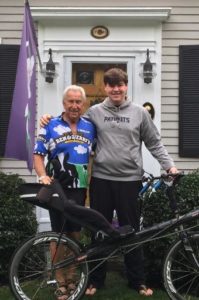August Cure Champion

Bernie Meggison
My grandson, Alex Meggison of Holly Springs, NC is 15-years-old and was diagnosed with type 1 diabetes (T1D) when he was 8. T1D is life threatening; every activity he does, every school exam he takes, every vacation he goes on, even simply a night over at a friend’s house, needs to be carefully planned for. The large bag(s) of medical supplies he carries with him, and all the devices he wears daily, have followed him everywhere for the last seven years and will be with him through high school, college and possibly the rest of his life.
Alex is a terrific kid who is recognized regularly at school for his character, academics and positive attitude—and was once even awarded the “Terrific Kid Award” by the North Carolina Wake County School System. Through JDRF, he and his parents regularly mentor other families afflicted with T1D. He makes me proud every day.
When his parents mentor families of newly diagnosed children, one of the first topics brought up is, “What should we expect?” When a child is initially diagnosed, the first step is getting their glucose under control and the next is intensive training on carb counting and administering insulin…then they are sent home. What happens at home is intense. It is like caring for a newborn—do you have enough supplies, do you have two to three of everything (should something fail, spoil, get lost), do you have emergency supplies throughout the house, in the car, in his kit? Scheduling appointments with schools, and notes for the school bus driver, neighborhood parents, and virtually anyone he or she may spend time with. You have log books for writing down carbs and meter readings, calls to the doctor multiple times a week, and arranging all the prescriptions.
There is no choice for parents—this is what they have to do, and it is 24/7. With time, you get into routines. For the first five years of Alex’s life with T1D, his parents would set their alarm for 2 a.m. to check his levels, often having to put glucose tabs in his mouth to bring him up from a dangerous low. Literally saving him from the damaging effects of high or low glucose.
JDRF funds research for a cure as well the management of T1D. Since Alex was diagnosed, new continuous glucose monitors have been developed so parents can monitor blood glucose levels from their phones, receiving alerts and trends so insulin pumps can be adjusted as needed. Pumps and glucose monitors have been better integrated so that a glucose high or low can trigger the pump to suspend or (hopefully soon) deliver insulin. Alex and his parents can now sleep through the night.
In a world where new apps and technology rapidly change our daily lives, improvements in the T1D space can be excruciatingly slow. There are revolutionary advancements being discovered every day, however it takes money to move these from the lab to reality.
At age 75, I’m taking part in the 100 mile JDRF Ride to Cure Diabetes in Amelia Island because I know that my fundraising efforts will help improve the lives of millions of people living with type 1 diabetes (T1D). If you would like to support my efforts and read more about why I ride, please visit http://www2.jdrf.org/site/TR?fr_id=6886&pg=personal&px=3200327.

